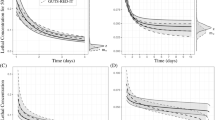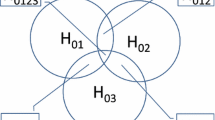Abstract
In ecotoxicology, critical effect concentrations are the most common indicators to quantitatively assess risks for species exposed to contaminants. Three types of critical effect concentrations are classically used: lowest/ no observed effect concentration (LOEC/NOEC), LC x (x% lethal concentration) and NEC (no effect concentration). In this article, for each of these three types of critical effect concentration, we compared methods or models used for their estimation and proposed one as the most appropriate. We then compared these critical effect concentrations to each other. For that, we used nine survival data sets corresponding to D. magna exposition to nine different contaminants, for which the time-course of the response was monitored. Our results showed that: (i) LOEC/NOEC values at day 21 were method-dependent, and that the Cochran–Armitage test with a step-down procedure appeared to be the most protective for the environment; (ii) all tested concentration–response models we compared gave close values of LC50 at day 21, nevertheless the Weibull model had the lowest global mean deviance; (iii) a simple threshold NEC-model both concentration and time dependent more completely described whole data (i.e. all timepoints) and enabled a precise estimation of the NEC. We then compared the three critical effect concentrations and argued that the use of the NEC might be a good option for environmental risk assessment.



Similar content being viewed by others
References
Altman D, Bland J (1995) Absence of evidence is not evidence of absence. Br Med J 311:485–485
Armitage P, Colton T (2005) Trend test for counts and proportions in encyclopedia of biostatistics, 2nd edn, vol 8 (5516–5522). Wiley, Chichester
Baas J, Jager T, Kooijman SALM (2009) Estimation of no effect concentrations from exposure experiments when values scatter among individuals. Ecol Model 220:411–418
Bedaux J, Kooijman SALM (1994) Statistical analysis of bioassays, based on hazard modeling. Environ Ecol Stat 1:303–314
Billoir E, Delignette-Muller ML, Péry A, Charles S (2008) A Bayesian approach to analyzing ecotoxicological data. Environ Sci Technol 42:8978–84
Billoir E, Delignette-Muller ML, Péry A, Geffard O, Charles S (2008) Statistical cautions when estimating DEBtox parameters. J Theor Biol 254:55–64
de Bruijn J, Hof M (1997) How to measure no effect. Part IV: how acceptable is the EC x from an environmental policy point of view?. Environmetrics 8:263–267
Cairns J (1992) The threshold problem in ecotoxicology. Ecotoxicology 1:3–16
Chapman P, Caldwell R, Chapman P (1996) A warning: NOECs are inappropriate for regulatory use. Environ Toxicol Chem 15:77–79
Crane M, Newman M (2000) What level of effect is a no observed effect? Environ Toxicol Chem 19:516–519
Delignette-Muller ML, Forfait C, Billoir E, Charles S (2011) A new perspective on the Dunnett procedure: filling the gap betweenNOEC/LOEC and EC x concepts. Environ Toxicol Chem 30:2888–2891
Ducrot V, Billoir E, Péry A, Garric J, Charles S (2010) From individual to population level effects of toxicants in the tubicifid Branchiura sowerbyi using threshold effect models in a Bayesian framework. Environ Toxicol Chem 44:3566–71
Fox D (2008) NECS, NOECS and the EC X . Australas J Ecotoxicol 14:7–9
Fox D (2010) A Bayesian approach for determining the no effect concentration and hazardous concentration in ecotoxicology. Ecotoxicol Environ Saf 73:123–131
Gelman A, Rubin D (1992) Inference from iterative simulation using multiple sequences. Stat Sci 7:457–511
van der Hoeven N (1997) How to measure no effect. Part III : statistical aspects of NOEC, EC x and NEC estimates. Environmetrics 8:255–261
van der Hoeven N (2004) Current issues in statistics and models for ecotoxicological risk assessment. Acta Biotheor 52:201–217
van der Hoeven N, Noppert F, Leopold A (1997) How to measure no effect. Part I: towards a new measure of chronic toxicity in ecotoxicology. Introduction and workshop results. Environmetrics 8:241–248
Holm S (1979) A simple sequentially rejective multiple test procedure. Scand J Stat 6:65–70
Isnard P, Flammarion P, Roman G, Babut M, Bastien P, Bintein S, Esserméant L, Férard J, Gallotti-Schmitt S, Saouter E, Saroli M, Thiébaud H, Tomassone R, Vindimian E (2001) Statistical analysis of regulatory ecotoxicity tests. Chemosphere 45:659–69
Jager T (2011) Some good reasons to ban EC x and related concepts in ecotoxicology. Environ Sci Technol 45:8180–8181
Jonckheere A (1954) A distribution-free k-sample test against ordered alternatives. Biometrika 41:133–145
Kooijman SALM, Bedaux J (1996) The analysis of aquatic toxicity data. VU University Press, Amsterdam
Lopes C, Charles S, Vollat B, Garric J (2009) Toxicity of ivermectin on cladocerans: comparison of toxic effects on Daphnia and Ceriodaphnia species. Environ Toxicol Chem 28:2160–2166
Manar R, Bessi H, Vasseur P (2009) Reproductive effects and bioaccumulation of chlordane in Daphnia magna. Environ Toxicol Chem 28:2150–2159
Nelder J (1999) From statistics to statistical science. J R Stat Soc Ser D (The Statistician) 48:257–267
Newman M (2008) “What exactly are you inferring?” a closer look at hypothesis testing. Environ Toxicol Chem 27:1013–1019
Ntzoufras I (2009) Bayesian modeling using WinBugs. Wiley Series in computational statistics. Hoboken, NJ
OECD (1998) Guidelines for testing of chemicals no 211: Daphnia magna reproduction test. Technical report, Organisation for Economic Cooperation and Development
OECD (2006) Current approaches in the statistical analysis of ecotoxicity data: a guidance to application. Technical report, Organisation for Economic Cooperation and Development
Pires A, Branco J, Picado A, Mendonca E (2002) Models for the estimation of a ‘no effect concentration’. Environmetrics 13(1):15–27
Plummer M (2010) R package version 2.1.0-10
R Development Core Team (2010) R: A language and environment for statistical computing. R foundation for statistical computing, Vienna, Austria. URL http://www.R-project.org/. ISBN 3-900051-07-0
Ritz C (2010) Toward a unified approach to dose-response modeling in ecotoxicology. Environ Toxicol Chem 29:220–229
Santojanni A, Gorbi G, Sartore F (1995) Prediction of mortality in chronic toxicity tests on Daphnia magna. Water Res 29:1453–1459
van Straalen N (1997) How to measure no effect. Part II: threshold effects in ecotoxicology. Environmetrics 8:249–253
Warne MSJ, van Dam R (2008) NOEC and LOEC data should no longer be generated or used. Australas J Ecotoxicol 14:1–5
Wennig R (2000) Threshold values in toxicology-useful or not? Forensic Sci Int 113:323–330
Wollenberger L, Halling-Sørensen B, Kusk K (2000) Acute and chronic toxicity of veterinary antibiotics to Daphnia magna. Chemosphere 40:723–730
Acknowledgments
We would like to thank Martyn Plummer for developing the useful JAGS and r-jags tools and David Fox for his precious comments. We also would like to thank the French Ministry of Higher Education and Research for providing financial support.
Author information
Authors and Affiliations
Corresponding author
Rights and permissions
About this article
Cite this article
Forfait-Dubuc, C., Charles, S., Billoir, E. et al. Survival data analyses in ecotoxicology: critical effect concentrations, methods and models. What should we use?. Ecotoxicology 21, 1072–1083 (2012). https://doi.org/10.1007/s10646-012-0860-0
Accepted:
Published:
Issue Date:
DOI: https://doi.org/10.1007/s10646-012-0860-0




